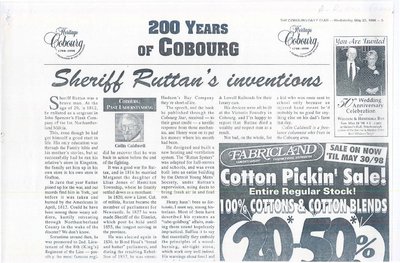THE COBOURG DAILY STAR – Wednesday, May 20, 1998 – 5
1789-1998
A Celebration of First Settlement
200 YEARS OF COBOURG
Sheriff Ruttan’s inventions
Colin Caldwell
Sheriff Ruttan was a brave man. At the age of 20, in 1812, he enlisted as a sergeant in John Spencer's Flank Company of the 1st. Northumberland Militia.
This, even though he had got himself a good start in life. His only education was through the Family bible and his mother's stories, but so successfully had he run his relative's store in Kingston, the family set him up in his own store in his own store in Grafton.
In June that year Ruttan joined up for the war, and our records find him in York, just before it was taken and burned by the Americans in April, 1813. Could he have been among those weary soldiers, hastily retreating through Northumberland County in the wake of the disaster? We don't know.
Sometime around then, he was promoted to 2nd. Lieutenant of the 8th (King's) Regiment of the Line – possibly the most famous regiment of that war.
We next catch up with him in 1814 at the Battle of Lundy's Lane. We find the story in what must have been a personal memoir, recorded by a friend after Ruttan's death.
In the dusk, toward the end of that closely-fought, confused fight, Ruttan found himself reconnoitering some soldiers to his front by "quietly advancing under cover of a fence and lying trees," until he discovered "long-tailed coats turned up with white" by which he knew it was the enemy.
He quickly scuttled back into his own lines and his men prepared to receive a volley of musket and cannon fire from the Americans. Ruttan escaped the first salvo, but on the second, he said, he "scarcely felt the shock, and was conscious only that…he was involuntarily brought upon both feet (they were taught to fire on one knee) and turned quite round."
A few steps toward his own rear…and he forgot everything until he awoke in the early morning hours, lying on a blanket, with a surgeon standing over him, declaring "Done for!" and then turning ominously away.
Unlike so many young men of those days, Ruttan recovered from the musket ball that had almost removed his entire shoulder. So well did he recover that he was back in action before the end of the fighting.
It was a good war for Ruttan, and in 1816 he married Margaret the daughter of Elias Jones of Hamilton Township, where he finally settled down as a merchant.
In 1820, now a Lieut. Col. of militia, Ruttan became the member of parliament for Newcastle. In 1827 he was made Sheriff of the District, which post he held until 1855, the longest serving in the province.
He was elected again in 1836, to Bond Head's "bread and butter" parliament, and during the resulting Rebellion of 1837, he was unanimously chosen speaker.
In 1834 he chaired a commission looking into the development of the Trent waterway, a project he whole-heartedly endorsed. In 1851, he referred a young Sandford Fleming to the Postmaster General as a potential designer of Canada's first postage stamp.
A very respectable career, one might say. And all that time Ruttan's real love was air-conditioning.
This curiously modern note is entirely typical of Ruttan. He became convinced that everything people in those days thought about heating and their health was wrong. So certain was he, that in late 1848 he gave a talk on it, to the Cobourg Mechanics Institute.
In his speech, he explained, in philosophically sound arguments, that their fire-places didn't really heat their house, that opening the window didn't air out the room, that their wives' expensive turkey carpets were a waste of money and might be killing everyone, and that Upper Canada was running out of wood.
Telling Upper Canadians they were running out of anything - except perhaps money - was brave enough, but saying there might, someday, be a shortage of wood is simply awe-inspiring.
This is like telling the Hudson's Bay Company they're short of ice.
The speech, and the book he published through the Cobourg Star, received - to their great credit - a terrific response from those mechanics, and Henry went on to put his money where his mouth had been.
He designed and built a new heating and ventilation system. The "Ruttan System" was adapted for hall-stoves and schools, and was even built into an entire building by the Detroit Young Mens' Society, under Ruttan's supervision, using ducts to bring fresh air in and foul out.
Henry hasn't been so fortunate, I must say, among historians. Most of them have described his systems as "rube-goldberg" affairs, making them sound hopelessly impractical. Suffice it to say that essentially they embody the principles of a wood-burning, air-tight stove, which work very well indeed. His warnings about fossil and other fuel consumption need no special pleading to my ears.
Then again, while "wondering what could be done about railway passenger cars sitting motionless in the blazing sun", (I wonder which local railway that was!) Ruttan adapted his principles of ventilation to the construction of "the first every air-conditioned passenger vehicle".
This device was ultimately used by the Grand Trunk, New York & Erie and Boston & Lowell Railroads for their luxury cars.
His devices were all built at the Victoria Foundry in Cobourg, and I'm happy to report that Ruttan died a wealthy and respected man as a result.
Not bad, on the whole, for a kid who was once sent to school only because an injured hand meant he'd probably be no good for anything else on his dad's farm that day.
Colin Caldwell is a freelance columnist who lives in the Cobourg area.


